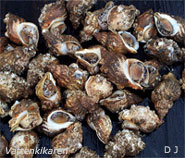
|
|
When the market steers
In France, the common whelk was intensively
fished in the southern areas of the English channel during the early 1980´s.
During this period the French applied a minimum size of 35mm, in spite of
that the common whelk is not sexually mature until it reaches about 55mm.
This was catastrophic for the fishing industry as the average weight of
meat in the whelk sunk from 30g in 1974 to about 10g in 1983. Profitability
deteriorated rapidly as one did not get paid as much for small whelks as
the large. French fishing has in spite of this continued and new areas have
been found.
In spite of the diminishing whelk population in the southern
and central North Sea, populations are still large enough for profitable
fishing to continue. Several countries, such as England and Ireland have
recently increased their whelk fishing quotas. The increased demand in the
Far East can possibly lead to over-fishing. Many countries have imposed
regulations of minimum size after weighing market demands and Biological
advice.

A sign of overfishing of the common whelk is the reduction
of the average size.
Knowledge and regulations are necessary for tenable fishing
Without relevant regulations, overfishing
will occur, which in the long term will lead to a collapse of the local
fishing industry. Because our knowlege of their biology is still relatively
little, it is necessary to be restrictive when regulating fishing. Because,
as yet there is no whelk fishing industry in Sweden, we have a perfect chance
to regulate and still facilitate the existance of a lasting population for
the future. Because the species shows large geographical variations, even
within the same maritime area, it is important that the species and its
populations are studied closely in those areas that will be fished.
It is we people who decide if we want to have a flourishing
whelk population in our sea. With knowledge and common sense, this should
not be a problem, but earlier experiences speak for themselves.......
These pages about the common whelk are part of a student project in Marine
ecology at the University of Gothenburg.
Helene Ek
|

|
Page 15
of 15
|
|
|